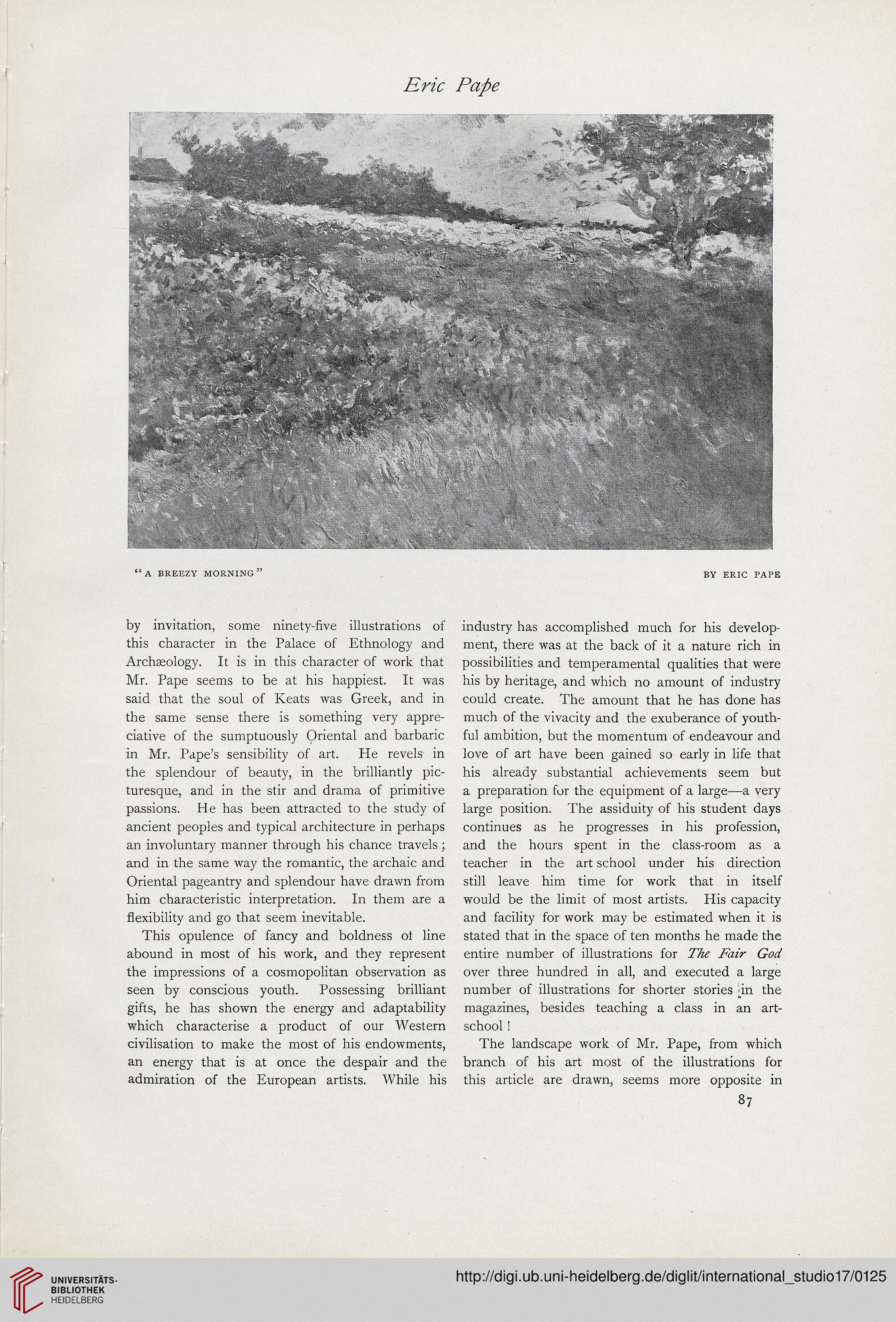Eric Pape
“ A BREEZY MORNING
BY ERIC PAPE
by invitation, some ninety-five illustrations of
this character in the Palace of Ethnology and
Archaeology. It is in this character of work that
Mr. Pape seems to be at his happiest. It was
said that the soul of Keats was Greek, and in
the same sense there is something very appre-
ciative of the sumptuously Oriental and barbaric
in Mr. Pape’s sensibility of art. He revels in
the splendour of beauty, in the brilliantly pic-
turesque, and in the stir and drama of primitive
passions. He has been attracted to the study of
ancient peoples and typical architecture in perhaps
an involuntary manner through his chance travels;
and in the same way the romantic, the archaic and
Oriental pageantry and splendour have drawn from
him characteristic interpretation. In them are a
flexibility and go that seem inevitable.
This opulence of fancy and boldness ot line
abound in most of his work, and they represent
the impressions of a cosmopolitan observation as
seen by conscious youth. Possessing brilliant
gifts, he has shown the energy and adaptability
which characterise a product of our Western
civilisation to make the most of his endowments,
an energy that is at once the despair and the
admiration of the European artists. While his
industry has accomplished much for his develop-
ment, there was at the back of it a nature rich in
possibilities and temperamental qualities that were
his by heritage, and which no amount of industry
could create. The amount that he has done has
much of the vivacity and the exuberance of youth-
ful ambition, but the momentum of endeavour and
love of art have been gained so early in life that
his already substantial achievements seem but
a preparation for the equipment of a large—a very
large position. The assiduity of his student days
continues as he progresses in his profession,
and the hours spent in the class-room as a
teacher in the art school under his direction
still leave him time for work that in itself
would be the limit of most artists. His capacity
and facility for work may be estimated when it is
stated that in the space of ten months he made the
entire number of illustrations for The Fair God
over three hundred in all, and executed a large
number of illustrations for shorter stories fin the
magazines, besides teaching a class in an art-
school !
The landscape work of Mr. Pape, from which
branch of his art most of the illustrations for
this article are drawn, seems more opposite in
87
“ A BREEZY MORNING
BY ERIC PAPE
by invitation, some ninety-five illustrations of
this character in the Palace of Ethnology and
Archaeology. It is in this character of work that
Mr. Pape seems to be at his happiest. It was
said that the soul of Keats was Greek, and in
the same sense there is something very appre-
ciative of the sumptuously Oriental and barbaric
in Mr. Pape’s sensibility of art. He revels in
the splendour of beauty, in the brilliantly pic-
turesque, and in the stir and drama of primitive
passions. He has been attracted to the study of
ancient peoples and typical architecture in perhaps
an involuntary manner through his chance travels;
and in the same way the romantic, the archaic and
Oriental pageantry and splendour have drawn from
him characteristic interpretation. In them are a
flexibility and go that seem inevitable.
This opulence of fancy and boldness ot line
abound in most of his work, and they represent
the impressions of a cosmopolitan observation as
seen by conscious youth. Possessing brilliant
gifts, he has shown the energy and adaptability
which characterise a product of our Western
civilisation to make the most of his endowments,
an energy that is at once the despair and the
admiration of the European artists. While his
industry has accomplished much for his develop-
ment, there was at the back of it a nature rich in
possibilities and temperamental qualities that were
his by heritage, and which no amount of industry
could create. The amount that he has done has
much of the vivacity and the exuberance of youth-
ful ambition, but the momentum of endeavour and
love of art have been gained so early in life that
his already substantial achievements seem but
a preparation for the equipment of a large—a very
large position. The assiduity of his student days
continues as he progresses in his profession,
and the hours spent in the class-room as a
teacher in the art school under his direction
still leave him time for work that in itself
would be the limit of most artists. His capacity
and facility for work may be estimated when it is
stated that in the space of ten months he made the
entire number of illustrations for The Fair God
over three hundred in all, and executed a large
number of illustrations for shorter stories fin the
magazines, besides teaching a class in an art-
school !
The landscape work of Mr. Pape, from which
branch of his art most of the illustrations for
this article are drawn, seems more opposite in
87




